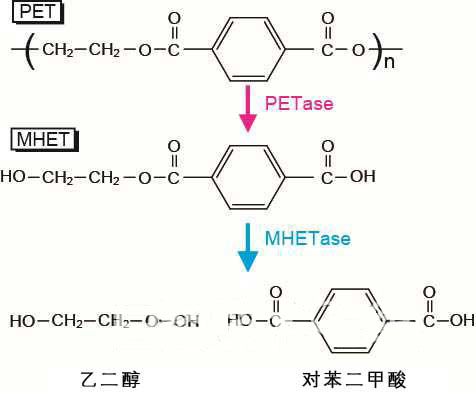Japanese researchers find bacteria that can break PET bottles into water and carbon dioxide
 |
201-F6 strain grown on PET film (left) and traces of decomposition observed after cleaning film surface (right)

Decomposition of PET into Terephthalic Acid Monomer and Ethylene Glycol Monomer by Two Enzymes
Keio University, Kyoto University of Technology, Teijin, and ADEKA announced on March 11, 2016 that they discovered bacteria that had grown through the decomposition of polyethylene terephthalate (PET) and identified them. Decomposition principle. This finding upsets the traditional claim that PET is a substance that cannot be biodegraded in nature, and is expected to contribute to the development of recycling technology for PET products.
PET is made from petroleum and is widely used in beverage bottles and clothing. However, in 2013, the total global production of PET resin was approximately 56 million tons, while recycling was only 37% of the PET bottle production (613 million tons) and 4.1% of the total PET resin production. If PET is used as a nutrient source, PET energy recycling and reuse of low-energy and environment-friendly models can be realized. Therefore, the researchers have explored PET-decomposing bacteria through this research.
The researchers collected a variety of environmental samples, and put them into a culture medium using PET film as the main carbon source. As a result, it was found that various microorganisms were accumulated on the PET film and decomposed. And successfully decomposing a powerful PET-decomposing bacteria from this microbiota. This bacteria was named "Ideonella sakaiensis strain 201-F6 strain" because it was derived from an environmental sample collected in Osaka City, Osaka Prefecture. The study found that the 201-F6 strain can decompose PET and use it as a nutrient source for breeding.
The researchers genomically sequenced the bacterium to find the gene sequence of an enzyme similar to the previously discovered enzymes that hydrolyzed PET. The functional analysis of its gene product, the protein, revealed that this enzyme has the ability to hydrolyze PET. It has also been confirmed that this enzyme prefers to decompose PET as compared with the PET hydrolyzed enzyme previously found, and also has a very high decomposition activity at a strong, room temperature PET construction. The researchers named the enzyme "PETase."ã‚š
Moreover, the researchers also noticed a characteristic of PETase, that is, after hydrolyzing PET, it mainly generates MHET (a compound formed by the dehydration and condensation polymerization of terephthalic acid single molecule and ethylene glycol single molecule). Perform other reactions. The researchers believe that there may be MHET hydrolyzing enzymes, so the complete gene expression analysis of the 201-F6 strain revealed that the protein encoded by a gene similar to PETase has the ability to rapidly hydrolyze MHET. The researchers named the new enzyme "MHETase."
From these results, the researchers found that the 201-F6 strain can use PETase and MHETase enzymes to efficiently decompose PET into terephthalic acid monomer and ethylene glycol monomer. The resulting terephthalic acid and ethylene glycol are further decomposed by many microorganisms containing the 201-F6 strain and eventually become carbon dioxide and water. The use of biodegradable PET is not only less energy-intensive but also more environmentally friendly than chemical treatment. The results of this research have been published in the science journal Science published on March 10th (US Eastern Time). (Special Contributor: Kudosuke)
ZHEJIANG KINGSIR VALVE CO., LTD. , https://www.kingsirvalves.com